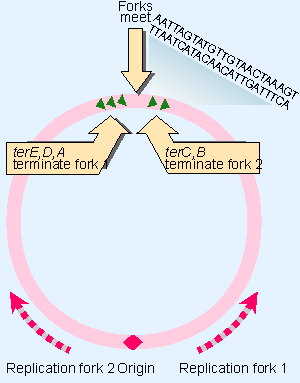3. The bacterial genome is a single circular replicon
12.3 The bacterial genome is a single circular replicon |
To be properly inherited, a bacterial replicon should support several functions:
- Initiating a replication cycle.
- Controlling the frequency of initiation events.
- Segregating replicated chromosomes to daughter cells.
The first two functions both are properties of the origin. Segregation could be an independent function, but in prokaryotic systems it is usually determined by sequences in the vicinity of the origin. Origins in eukaryotes do not function in segregation, but are concerned only with replication.
As a general principle, the DNA constituting an origin can be isolated by its ability to support replication of any DNA sequence to which it is joined. When DNA from the origin is cloned into a molecule that lacks an origin, this will create a plasmid capable of autonomous replication only if the DNA from the origin contains all the sequences needed to identify itself as an authentic origin for replication.
Origins now have been identified in bacteria, yeast, chloroplasts, and mitochondria, although not in higher eukaryotes. A general feature is that the overall sequence composition is A PT-rich. We assume this is related to the need to melt the DNA duplex to initiate replication (Zyskind and Smith, 1980).
The genome of E. coli is replicated bidirectionally from a single origin, identified as the genetic locus oriC. The addition of oriC to any piece of DNA creates an artificial plasmid that can replicate in E. coli. By reducing the size of the cloned fragment of oriC, the region required to initiate replication has been equated with a fragment of 245 bp. (We discuss the properties of oriC and its interaction with the replication apparatus in more detail in the next chapter.)
Prokaryotic replicons are usually circular, so that the DNA forms a closed circle with no free ends. Circular structures include the bacterial chromosome itself, all plasmids, and many bacteriophages. They are also common in chloroplast and mitochondrial DNAs. Replication of a circular molecule avoids the problem of how to replicate the ends of a linear molecule (see later), but poses the problem of how to terminate replication (Cairns, 1963).
The bacterial chromosome is replicated bidirectionally as a single unit from oriC. Two replication forks initiate at oriC and move around the genome (at approximately the same speed) to a meeting point. Termination occurs in a discrete region. One interesting question is what ensures that the DNA is replicated right across the region where the forks meet. Following the termination of DNA replication itself, enzymes that manipulate higher-order structure of DNA are required for the two daughter chromosomes to be physically separated (Steck and Drlica, 1984).
Sequences that cause termination are called ter sites. A ter site contains a short (~23 bp) sequence that causes termination in vitro. The termination sequences function in only one orientation. Termination requires the product of the tus gene, which codes for a protein that recognizes the consensus sequence and prevents the replication fork from proceeding (see 13 DNA replication).
 |
Figure 12.7 Replication termini in E. coli are located beyond the point at which the replication forks actually meet. |
Termination in E. coli has the interesting features reported in Figure 12.7. We know that the replication forks usually meet and halt replication at a point midway round the chromosome from the origin. But two termination regions (terE,D,A and terC,B) have been identified, located ~100 kb on either side of this meeting point. Each contains multiple terminators. Each terminus is specific for one direction of fork movement, and they are arranged in such a way that each fork would have to pass the other in order to reach the terminus to which it is susceptible. This arrangement creates a "replication fork trap;" if for some reason one fork is delayed, so that the forks fail to meet at the usual central position, the more rapid fork will be trapped at the ter region to wait for the arrival of the slow fork.
A conflict arises when the replication fork meets an RNA polymerase traveling in the opposite direction, that is, toward it. Can it displace the RNA polymerase? Or do both replication and transcription come to a halt? An indication that these encounters cannot easily be resolved is provided by the organization of the E. coli chromosome. Almost all active transcription units are oriented so that they are expressed in the same direction as the replication fork that passes them. The exceptions all comprise small transcription units that are infrequently expressed. The difficulty of generating inversions containing highly expressed genes argues that head-on encounters between a replication fork and a series of transcribing RNA polymerases may be lethal.
| Reviews | |
| Brewer, B. J. (1988). When polymerases collide: replication and transcriptional organization of the E. coli chromosome. Cell 53, 679-686. | |
| Research | |
| Cairns, J. (1963). The bacterial chromosome and its manner of replication as seen by autoradiography. J. Mol. Biol. 6, 208-213. | |
| Liu, B., Wong, M. L., and Alberts, B. (1994). A transcribing RNA polymerase molecule survives DNA replication without aborting its growing RNA chain. Proc. Nat. Acad. Sci. USA 91, 10660-10664. | |
| Steck, T. R. and Drlica, K. (1984). Bacterial chromosome segregation: evidence for DNA gyrase involvement in decatenation. Cell 36, 1081-1088. | |
| Zyskind, J. W. and Smith, D. W. (1980). Nucleotide sequence of the S. typhimurium origin of DNA replication. Proc. Nat. Acad. Sci. USA 77, 2460-2464. | |
- Challenging the Unpredictable: Changeable Order Management Systems
- Context Management of ERP Processes in Virtual Communities
- Distributed Data Warehouse for Geo-spatial Services
- A Hybrid Clustering Technique to Improve Patient Data Quality
- Relevance and Micro-Relevance for the Professional as Determinants of IT-Diffusion and IT-Use in Healthcare